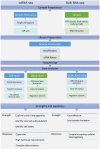Single-cell RNA sequencing in breast cancer: Understanding tumor heterogeneity and paving roads to individualized therapy
- PMID: 32654419
- PMCID: PMC7427308
- DOI: 10.1002/cac2.12078
Single-cell RNA sequencing in breast cancer: Understanding tumor heterogeneity and paving roads to individualized therapy
Abstract
Single-cell RNA sequencing (scRNA-seq) is a novel technology that allows transcriptomic analyses of individual cells. During the past decade, scRNA-seq sensitivity, accuracy, and efficiency have improved due to innovations including more sensitive, automated, and cost-effective single-cell isolation methods with higher throughput as well as ongoing technological development of scRNA-seq protocols. Among the variety of current approaches with distinct features, researchers can choose the most suitable method to carry out their research. By profiling single cells in a complex population mix, scRNA-seq presents great advantages over traditional sequencing methods in dissecting heterogeneity in cell populations hidden in bulk analysis and exploring rare cell types associated with tumorigenesis and metastasis. scRNA-seq studies in recent years in the field of breast cancer research have clustered breast cancer cell populations with different molecular subtypes to identify distinct populations that may correlate with poor prognosis and drug resistance. The technology has also been used to explain tumor microenvironment heterogeneity by identifying distinct immune cell subsets that may be associated with immunosurveillance and are potential immunotherapy targets. Moreover, scRNA-seq has diverse applications in breast cancer research besides exploring heterogeneity, including the analysis of cell-cell communications, regulatory single-cell states, immune cell distributions, and more. scRNA-seq is also a promising tool that can facilitate individualized therapy due to its ability to define cell subsets with potential treatment targets. Although scRNA-seq studies of therapeutic selection in breast cancer are currently limited, the application of this technology in this field is prospective. Joint efforts and original ideas are needed to better implement scRNA-seq technologies in breast cancer research to pave the way for individualized treatment management. This review provides a brief introduction on the currently available scRNA-seq approaches along with their corresponding strengths and weaknesses and may act as a reference for the selection of suitable methods for research. We also discuss the current applications of scRNA-seq in breast cancer research for tumor heterogeneity analysis, individualized therapy, and the other research directions mentioned above by reviewing corresponding published studies. Finally, we discuss the limitations of current scRNA-seq technologies and technical problems that remain to be overcome.
Keywords: Single-cell sequencing; breast cancer; individualized therapy; tumor heterogeneity.
© 2020 The Authors. Cancer Communications published by John Wiley & Sons Australia, Ltd. on behalf of Sun Yat-sen University Cancer Center.
Conflict of interest statement
The authors declare no conflict of interest. The funders had no role in the design of the study; in the collection, analyses, or interpretation of data; in the writing of the manuscript, or in the decision to publish the results.
Figures


References
Publication types
MeSH terms
LinkOut - more resources
Full Text Sources
Other Literature Sources
Medical
Miscellaneous

